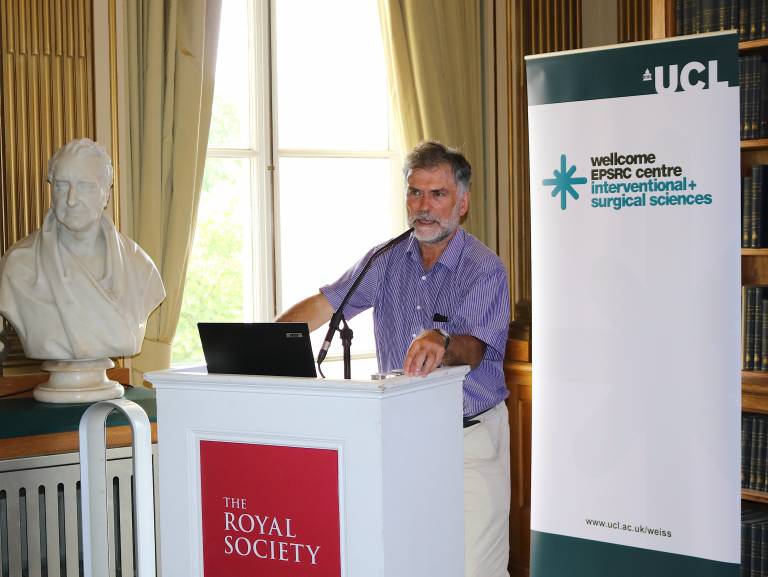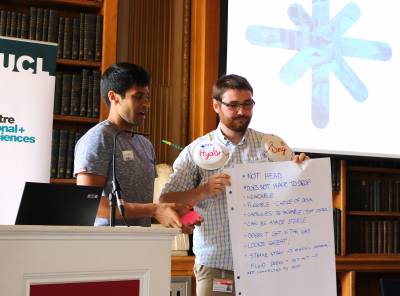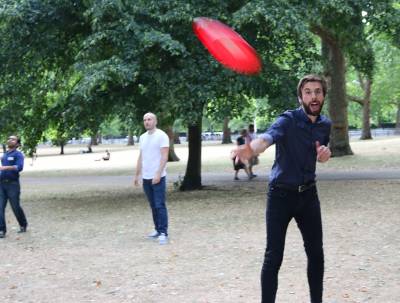WEISS Away Day: launching the centre's new platforms
31 July 2018
On 18 July, the WEISS community came together for an action-packed Away Day.
 Hosted at the Royal Society, the location was a fitting backdrop for celebrating scientific discovery, innovation, and collaboration.
Hosted at the Royal Society, the location was a fitting backdrop for celebrating scientific discovery, innovation, and collaboration.
Presenting the new WEISS platforms
Professor David Hawkes, Director of WEISS, opened the event opened with presentations around the centre's new platforms.
We heard from the following speakers about their pioneering research and how this was enabled by WEISS:
Dr Vanessa Diaz & Dr Rui Loureiro - Simulation platform for the development of new surgical devices and optimisation of personalised clinical procedures (SPEEDOP)
Vanessa and Rui spoke about the ways they are using simulation technology to train surgeons in complex surgical procedures and improve patient outcomes.
Vanessa has developed a pulsatile pump system which allows surgeons to prepare for aortic dissections - a challenging surgery with very serious risks. The computer-controlled system uses a phantom to simulate a specific patient's condition and allows a surgeon to explore the procedure in a completely safe environment.
Rui is applying simulation technology to the field of orthopaedics. His system allows orthopaedic surgeons to practice surgery in a safer, low-cost manner and receive meaningful feedback.
Dr Dean Barratt - Advanced ultrasound imaging modes for interventional applications
Dean and his colleagues are developing a software platform which will enable researchers to quickly and easily acquire ultrasound image data in a clinical setting.
Ultrasound is suitable for a wide-range of interventions but it has a few constraints - it is difficult to acquire high-quality in vivo images as well as real-time 3D imaging. Dean aims to resolve these issues through his platform and make ultrasound imaging a more accessible and versatile tool.
Dr Matt Clarkson - Surgical navigation platform with Python (SNAPPY)
An interventional centre such as WEISS needs a surgical guidance platform. However, the way software engineers approach building these platforms needs to change, argues Matt. We should stop thinking of code as something large-scale and set in stone, and instead consider it like Lego - we can build the components we need and reassemble when we need to. This allows researchers to use their time more effectively.
Matt is incorporating this ethos into his platform, SNAPPY, which holds human-computer interaction as its key element.
Dr Danail Stoyanov - Endoscopic imaging and vision (EndoVI)
Dan and his team are using augmented reality to assist surgeons during cancer surgery. During an endoscopy, surgeons need to visualise blood vessels - but these can be difficult to spot with the human eye. Dan's medical imaging technology uses a video overlay to amplify the motion of blood flow, improving the success rate of endoscopies and patient safety.
Professor Manish Tiwari - Soft miniature sensors and nanoengineered coatings: prototyping and clinical exploitation
By miniaturising the 3D printing process, Manish and his team are developing flexible nanostructures in the form of healthcare sensors and ultrasonic and photoacoustic probes. These tools will allow surgeons to work with an ever-increasing level of micro-precision.
Professor Adrien Desjardins - Optical ultrasound catheters for interventional imaging
Adrien and his colleagues are developing photoacoustic fibre-optic ultrasound technology which is microns thin. This technology can be used to provide high-resolution imaging in a range of interventions, including vascular surgery, urology and neurosurgery. This technology can integrate with MRI systems and has relatively low manufacturing costs.
Afternoon fun and games
After lunch, the teams were challenged with designing solutions to two clinical problems. They had to present their ideas and prototype to a discerning panel of WEISS 'Dragons'.

In just 30 minutes, the teams produced an impressive array of innovations - from a back-mounted water bladder to keep surgeons hydrated through to sensors that combat surgeon fatigue by blasting death metal.
Next, we were treated to a spectacular tour of the Royal Society's library and art collection. King Charles II founded the learned society by a royal charter in 1660 - and his signature is the first to adorn its Charter Book of Fellows. Growing over centuries, this historical record now reads as a 'who's-who' of the scientific world. Isaac Newton, Nigel Farraday, Charles Darwin and David Attenborough have all added their names to the document upon becoming Fellows.
We segued from fascinating scientific records to a game of Frisbee outside in the park, arranged by Dan Taylor, Public Engagement Coordinator.

The evening ended with canapes and drinks, allowing attendees to discuss ideas which came out of the day and plan future collaborations.
A special thanks to Kate Litwinczuk for her efforts in organising this event. Thank you as well to everyone who attended for making this such an enjoyable, productive day out.
 Close
Close

